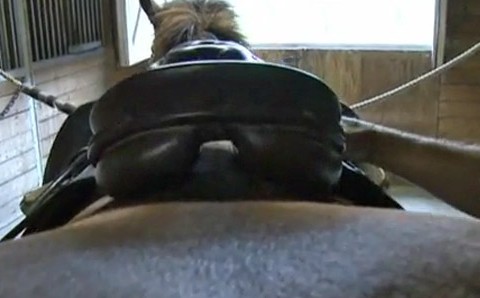Now I would like to talk to you about the channel width, also known as the gullet width. It is important to have no contact on the horse’s spine. The horse’s spine has the middle bone and on the side their are a couple of little spinal transfers. Right here (shown in video) you can see on this beautiful horse, the ridge, that is the horse’s ligament. We do not want to sit on that!
So the first thing you do, is you go to your horse at the base of the withers and gently press towards it until you hit that transfer. You see how he just stopped his back and how tight he got? I just do it to mark his spine with one hand, and then I put my other hand in between. What I like to see on this horse is the channel width on his saddle at least 4 fingers wide. Over here I have three saddles to choose from. One fits nice in the front, but as we take our hand towards the back there is only a 1 finger width, making this the incorrect choice. Here is one that is just 2 fingers wide all the way, again that is too narrow and it would sit on the ligament. Here is a saddle that has four finger clearance and that will be all the way free for the ligament.
Let me show you how you can see this. When you put the saddle on the horse, put it behind the shoulder and you can look all the way through from the front. When you look from the back, you can see the light shining through. It’s very important that the saddle is wide in the back too because when you ride around corners, the back swings over left to right.
When you put a saddle on that is too narrow in the channel, it would probably sit anywhere around here (shown in video). If you go to your horse and start rubbing his ligament, pay attention and you will see his back muscle tighten and hollow away. Using just a little pressure, you can obviously see his discomfort and see him shifting his weight. Why would we press on a ligament? It’s exactly the same if you kept rubbing the back of your hand after ten seconds. After a week of doing this everyday, you can’t even make a fist! So it’s very important not to sit on the ligament!
Let me put on a saddle with a narrow gullet. We see clearly from the back that the saddle sits on the spine, I can only imagine what will happen if he goes around corners, the whole panel sits right on the back bone! It is very uncomfortable and will cause long-term damage to the horse.
What will happen if the gullet is too wide? I have put on the horse with a chalk line the width of the spine. When you grab your horse with eight fingers and run down you feel the top of the ribs. Your panel should sit through here (shown in video). If you make a saddle where the gullet is too wide you start ripping the muscle of the ribs and your weight bearing surfaces become very very small. What we are trying to achieve is optimal weight bearing surface. If the gullet is too wide the channel either goes nice and wide but the extra contact area gets very small, or if my panel stays wide I start stripping the muscle from the ribs. The other problem that can happen if the channel is too wide is the back of the tree will push onto the vertebrae.
6 Foreign Drugstore Options That Can Save Customer’s MoneyProtecting Users of Online Pharmacies: The Fight Against Illegal Remedies

